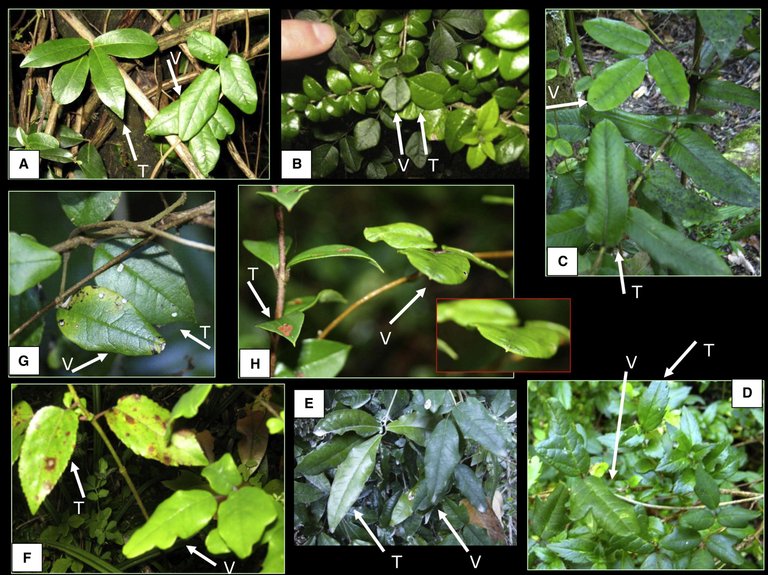🌱 Mimicry: The Master Of Masters 🌱
In the past I have shared all kinds of crazy mimicry examples from mother nature. Like the moth that mimics jumping spiders, the ant-like mantis and the gloworms of New Zealand that mimic the night sky.
Dunno why, but mimicry in the animal kingdom is a subject I always found quite fascinating. Of course, it isn't unique to the animal kingdom but also happens in plants, although to a lesser degree. And usually it's just not as impressive.
At least that's what I thought. Turns out that the true master of mimicry is actually a plant! How so?
Allow me to introduce you to Boquila trifoliolata, a plant species endemic to the temperate forests of central and southern Chile and Argentina. Locally it's known as voqui blanco or pilpil, and thanks to a decade old study it also earned the nickname chameleon vine. And that is for a really good reason!
But let's take things a bit from the start.
Boquila is a non parasitic vine that uses other "host" for structure and protection.
As of today, it is the only known plant know to engage in mimetic polymorphism. In simple words, it can mimic the leaves of multiple plant species, often simultaneously.
Once one of its vines approaches another plant it starts producing leaves similar to it. Sometimes the original leaves have to expand over 10 times their "regular" size to achieve that! And so far we know it can mimic at least 20 different species! Furthermore, it doesn't even need to come in actual contact. Close proximity seems to be enough!
Here's a photo from the paper that first described the mimicry abilities of Boquila. It's just amazing how many forms it can take!
But how can it do that?
Well, we just don't know, lol 😆
Some theories include horizontal gene transfer or the use of eye-like structures. Or whatever.
Another mystery of mother nature...waiting to be solved! For now all we have are speculations.
As always, see you soon with more crazy wonders from mother nature. In the meantime, here's a link to the study describing the phenomenon in more details. Fascinating stuff 😎
Posted Using INLEO

Am just reading about this with plants for the first time. I know this can be obtainable with animals but I’ve never heard about it for plants and I think this is just super awesome. Nature sure does have some wonders up the sleeves
That is really cool! There has to be some kind of genetic transfer to achieve that level of mimicry, either that or it's really an alien from outer space! Awesome find!
!DUO
You just got DUO from @thebighigg.
They have 1/1 DUO calls left.
Learn all about DUO here.
!DUO
You just got DUO from @trumpman.
They have 1/1 DUO calls left.
Learn all about DUO here.
Oh wow I had no idea a plant could mimic other plants... Who knows how it can do this
!PIZZA
BTW, did you stop reddit shares?
Yes, I have been a bit busy these days with life ufff
Do you mind if I do? Or you want to keep them for you?
Feel free, I'll leave em to you 😉
danke sehr!
$PIZZA slices delivered:
@davideownzall(2/15) tipped @trumpman
Come get MOONed!
There is also life, but micro :)
You received an upvote of 100% from Precious the Silver Mermaid!
Please remember to contribute great content to the #SilverGoldStackers tag to create another Precious Gem.
That’s crazy.
!pimp
My votes a bit drained so here’s a HSBI instead!
😜🥰🥰🥰🥰😜😜
Nature is amazing.
!GIFU
!lolz
lolztoken.com
now we just call him Phil.
Credit: reddit
@trumpman, I sent you an $LOLZ on behalf of logen9f
(2/10)
It sure is 🌱
!bbh !pimp
Wow, that is an interesting plant. I never thought it could even expand its size to mimic the leaves.
!pimp
nature wonders
The natural defense system is beyond our imagination.
mantis looks like a spider.
😅😎
its crazy how there are so many different species with more being discovered everyday
https://www.reddit.com/r/ScienceNcoolThings/comments/1k3tk8m/mimicry_the_master_of_masters/
The rewards earned on this comment will go directly to the people( @davideownzall ) sharing the post on Reddit as long as they are registered with @poshtoken. Sign up at https://hiveposh.com. Otherwise, rewards go to the author of the blog post.